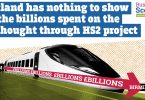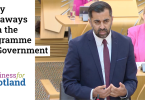
The last of the Autumn Statements laden with Brexit doom and gloom
In the past week the national accounts of two nations were put under the microscope, well one nation (the UK) and one region of that nation.
An Autumn Statement laden with Brexit doom and gloom shed light on the economic problems facing Scotland as part of the Union, and in Scotland, Common Weal weighed in with its Beyond GERS report. There is no way that GERS can be said to be a statement of the financial starting point for an independent Scotland, nor indicative of the direction Scotland’s finances would take following independence. The latter would depend on the policies followed by the government of an independent Scotland, the former on the deal done on debt and division of assets between Scotland and rUK.
The Common Weal report supports work published by Business for Scotland during the 2014 referendum, when we described what we called the independence bonus. It is clear that many costs associated with UK membership would not be included or would be radically altered in the starting point accounts of an independent Scotland. Obvious are ones such as the renewal of Trident, in which Scotland would not participate. The White Paper even pointed out that defence savings would be at least £500 million a year for a conventionally armed, independent Scotland. We also found more hidden savings that together would have amounted to up to £3.5 billion over the period of the first independent parliament.
Also, many of the changes through independence would not only reduce costs but add to Scotland’s revenues. One example would be the fact that Scotland pays for a population share of London-based civil servants whose remit covers the whole of the UK. Although most of these roles would be recreated in Scotland the cost of them is already included in GERS, and as wages are lower in Scotland than London, equivalent salary costs would be much lower and they would contribute PAYE and NI contributions in Scotland, thus increasing Scotland’s revenue while actually lowering our expenditure.
Office running costs including commercial rates in Glasgow, for example, are 41 per cent lower than London and work done by Dan MacDonald, now of the Sustainable Growth Commission, calculated that property costs in Scotland (including Edinburgh) could be 33 per cent lower, and that as little as three to four million square feet would be required for public sector workers an independent Scotland. Compare that with the 99 million square feet of property in London that Scotland contributes to as part of the UK – the list goes on and on.

GERS paints a picture of Scotland’s finances as part of the UK
However, GERS in itself does not need to be debunked as many claim, GERS does what it is supposed to do and paints a picture of Scotland’s finances as part of the UK, if those finances worsen then it only shows how the UK has mismanaged Scotland’s finances. Scotland did not get anywhere near the benefits of the oil boom that Norway continues to enjoy. London’s incompetent management of Scotland’s economy is demonstrated though policies such as maintaining artificially high values of Sterling for 35 years to help the financial services sector. That policy had the consequence of making Scottish exports too expensive for countries with weaker currencies and leading to artificially inflated levels of trade with England and lower international exports, creating deindustrialisation, mass unemployment, poverty and economic migration. You might even argue it worked for a while, but then the finance sector become bloated, the economy became unbalanced and the crash led to austerity, which slowed investment and cost jobs. Now all research states that Brexit looks set to damage Scotland’s economy to a far greater degree than the rest of the UK.
GERS, however, continues to demonstrate that Scotland’s onshore economy remains strong despite being part of the UK, not because of it, and that is still worth pointing out. However, the finances of an independent Scotland are complex to debate and unclear unless you have a clear set of policies to create a model from and that was (probably quite deliberately) left out of the White Paper as the focus was on the social, welfare and healthcare offering, which tactically undermined support for Labour, who were ill-advisedly leading the No campaign. It almost worked, creating a steady growth in support for Yes. But was it the best campaign for the first indyref? Probably, as Yes started so far behind, but indyref2 will require more policy detail and a clearer vision of how the better, fairer, greener and more successful Scotland we all want is affordable only through independence.
There are three elements to looking at the financial starting point of an independent Scotland. Firstly, the savings from independence as detailed above. Secondly, debt and asset negotiation, which both sides will debate to a standstill, and finally, a road map to shared prosperity in an independent Scotland, a positive vision not just of the type of society we want to create but a mechanism for affording the transition to a better Scotland.
Without that plan scaremongering can still have an impact, but even more importantly the slowly unfolding economic disaster that is Brexit gives the Yes movement the chance to offer Scotland a positive vision of change that compares and contrasts starkly with Westminster’s self-destructing Brexit omni-shambles. If the status quo no longer exists then it becomes a straight fight between the visions of both camps, and there is no positive vision for a post-Brexit UK that isn’t delusional, xenophobic and isolationist.

Farage and Trump – the traditional right is gaining ground in the West
The Yes movement needs to look at what’s happening in the world: the global elites are in trouble, the establishment is facing a wave of dissent that’s sweeping through political debate. The establishment is powerless in the face of an economic crisis it doesn’t understand and can’t fix. The economic policies that promised security have failed and widening wealth inequality has led to a fall in support for establishment parties in the western world.
In Greece, the left wing led the anti-establishment charge, in England, Ukip from the centre-right and in Austria, Norbert Hofer occupies the far-right. Donald Trump? Well, he just defies definition in terms of his political compass, does he even have one?
The point is it’s not about left and right, or even about the demise of the centrist parties, it’s more about frustration in the political elites, who just so happen to be mostly centrists. Bernie Sanders didn’t win and Jeremy Corbyn never will, but the Yes movement must offer clarity in this political chaos with a positive policy vision, the third piece of the jigsaw that unveils a wider picture and turns independence from a dream that never dies into a plan that won’t fail. Watch this space.








Scotland is not a ‘region of the UK’ but a country within the United Kingdom.
Well said Colin. For the life of me I cannot understand how the Tories have got away with ‘public bad, private good’ since the 1980s, now swallowed whole by the Red Tories. I can remember Parkinson, then Transport minister, advocating de-regulation of bus services and worshiping the God of choice. Look where that has got us in our stewardship of the planet.
The oil and gas industry is now heavily subsidised by the UK government taking it on in Scotland would only have a negative impact on our economy. Get real.
Brexit is a disaster but Scexit would only double the agony.
Forget independence and support the 65% trade with the rest of the UK rather than the thin thread of 15% with the Europe.
Learn to live in the real world and take some responsibility for UK policies.
Scotland is a key player in the UK and with our politicians whingeing and being consistently negative does us no credit.
At least for the moment let us show that Scotland is prepared to show statesmanship not constant carping.
The UK is not a nation and Scotland is not a region of any nation.
Privatisation of the UK’s oil and gas industry by the Tories in the 80s has cost the public finances at least £600 billion. This was lost to a mixture of inefficiencies resulting from fragmentation of the industry post privatisation, private profits, creative accounting and tax dodging, most of which was probably legal. Norway, by contrast, retained substantial state ownership of its oil and gas resources and has raised nearly three times more revenue than the UK despite producing 10% less oil and gas up to 2014.
Another result of privatisation was that the UK oil and gas industry became focused on London, not Scotland. It’s a myth that Aberdeen is the oil capital of Europe. London is where the top jobs and the main decisions are made and it’s where the substantial amounts of money involved in the industry are processed. With independence, Scotland’s oil and gas industry will become centred in Scotland. This will have a significant direct and indirect effect on our economy.
One of the first steps that an independent Scotland should take is to establish a Scottish equivalent of Norway’s Statoil. All fields should be required to have open-book accounting and an independent Scotland would thereby be able to clamp down on creative accounting and tax dodging, thus maximising the contribution that the industry makes to the public finances. Westminster’s cat and mouse game with the industry in relation to taxes and incentives has been a dismal failure.
Another benefit of establishing a Scottish equivalent of Statoil is that a coherent strategy could be developed to ensure that oil and gas resources are exploted in the most cost efficient manner by sharing infrastructure costs between adjacent fields. The privatised UK oil industry is uncoordinated and inefficient compared to Norway’s.
Better management and control of Scotland’s oil and gas resorces would result an a substantial positive impact on Scotland’s public finances. It is an opportunity that should not be ignored and it needs to be formally addressed before the next independence referendum.